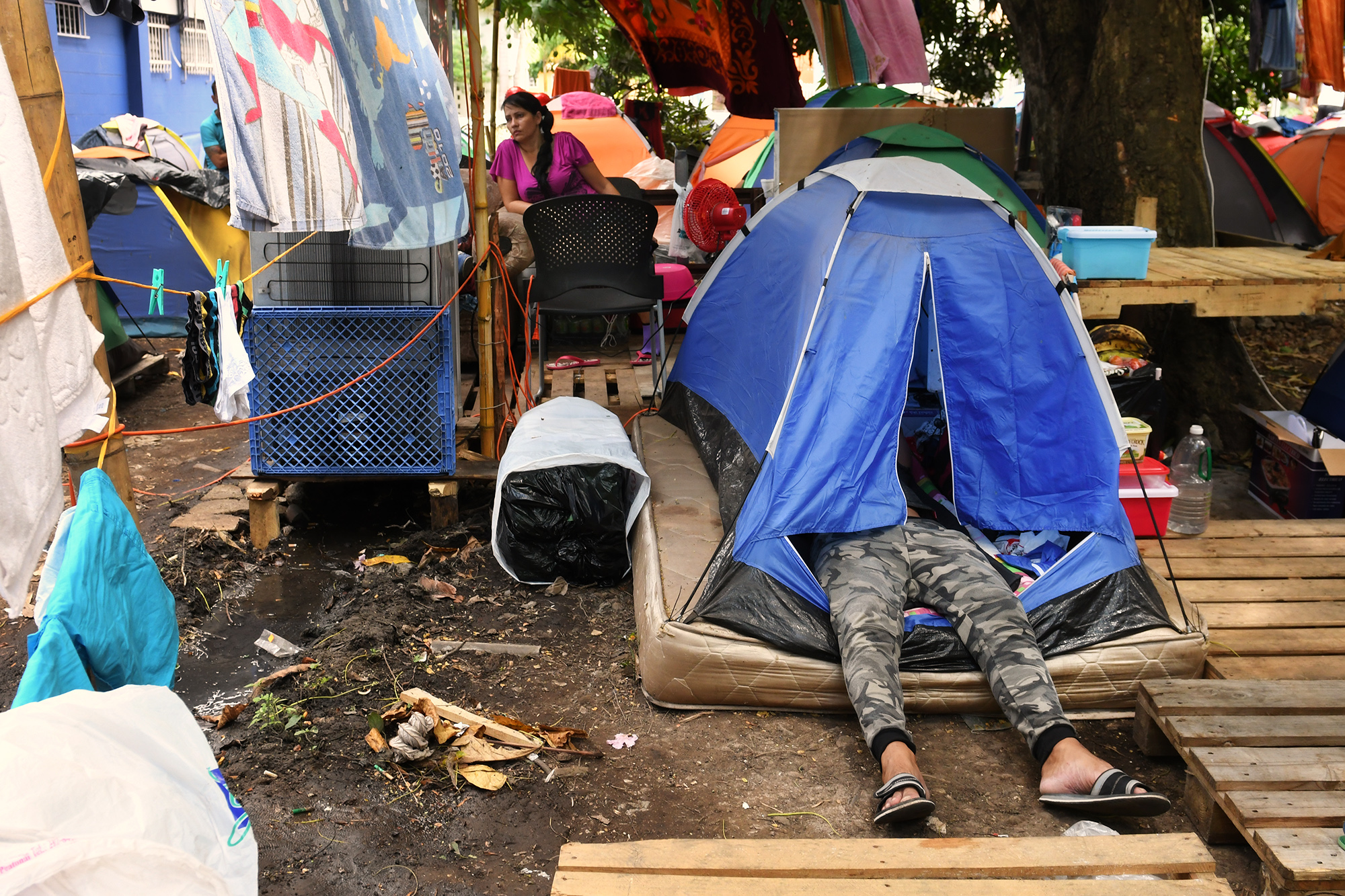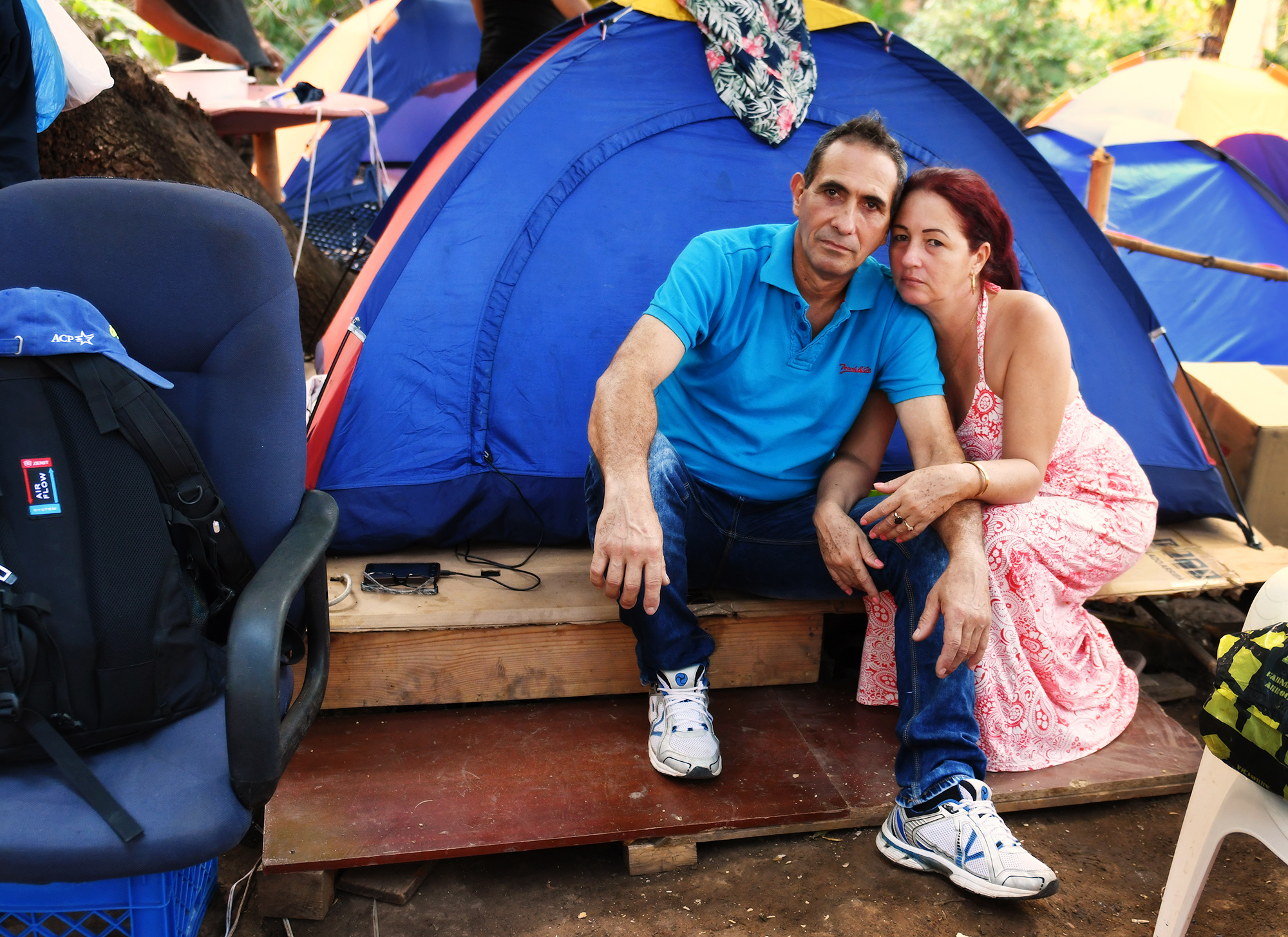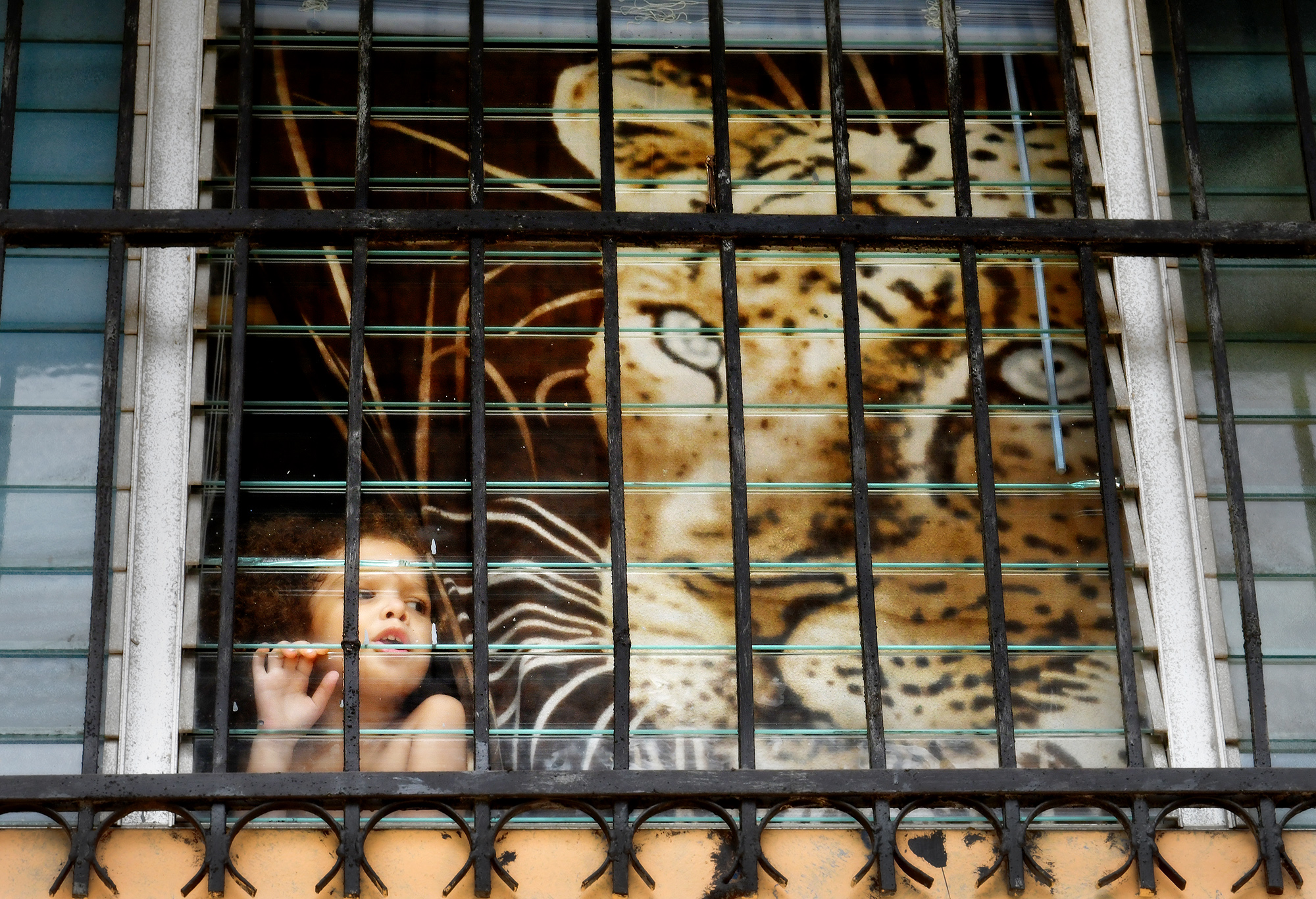Hundreds of Cubans are stuck in Panama, once a bridge to the United States, after the Obama administration reversed the “wet foot, dry foot” policy that allowed Cubans who had managed to make it to U.S. soil to stay.
PANAMA CITY, PANAMA – The Darien Gap – the 60 miles of lawless wilderness and swamp between Panama and Colombia – is one of the most dangerous jungles in the world. Aware of the almost inevitable disease, kidnapping or drowning, those who attempt the perilous journey through it feel that this is their only path to a promise of freedom and stability.
Yoana Crebpo Valdés, 31, remembers when she and her husband were among 62 other Cubans lined up at Colombia’s border, waiting anxiously to be divided into smaller groups to navigate through the wilderness separating them from Panama, the next stop on their journey from Cuba to the United States.
Yoana Crebpo Valdés said President Obama "broke the dreams of many Cubans in the jungle" when he used an executive order to end the "wet foot, dry foot" policy that allowed Cubans to automatically be able to claim asylum in the United States. ~ Photo by Anthony Amato
Only 13 of the original group made it through the jungle to Panama, including Valdés – who said she narrowly escaped drowning – and her husband.
Having survived the jungle, Valdés and her husband paused their journey in Panama before resuming their trek north.
But on January 12, three days before they set out for the United States, then-President Barack Obama slammed the door shut on her and untold numbers of other Cubans by reversing the “wet foot, dry foot” policy that allowed Cubans who had managed to make it to U.S. soil to stay.
“[Obama] broke the dreams of many Cubans in the jungle,” she said.
Valdés and her husband are among thousands of potential immigrants for whom Panama is no longer a path to a new beginning but a bottleneck. Adding to the uncertainty and desperation is the vow of the new U.S. administration to build a wall that would form a physical as well as a legal barrier to those seeking entry to the U.S. from the south.
“What Obama did was really mean,” said Victor Berrío, a Catholic deacon and director of the Cáritas shelter in Panama City. “These people are running away from violence to find a better life. Panama has always been used as a way to get to the U.S.”
Victor Berrío, a Catholic deacon and director of the Cáritas shelter in Panama City. ~ Photo by John Beale
A bridge between the north and the south, a connecting lifeline for those fleeing political and economic strife to pursue what Berrío calls the American Dream – this is what Panama had always been.
With its strong economy, global outlook and relatively welcoming population, Panama has traditionally been a more attractive country for temporary asylum than Mexico or other countries of Central America.
“Mexicans don’t treat immigrants well … but for many, it’s the only way for survival,” Berrío said.
The office-turned-shelter
A young Cuban girl waits along with hundreds of fellow Cubans. ~ Photo by John Beale
Berrío’s Cáritas shelter has been transformed out of what used to be the charity’s main office into a temporary home for 285 stranded Cubans, Valdés and her husband included.
A spread of tents, resembling one giant colorful, mismatched patchwork quilt, covers the ground. A maze of bamboo clotheslines cuts through the patches, providing privacy within the tented community.
Extension cords run from tent to tent, operating fans and mini grills. Balboa beer bottles – from a popular Panamanian beverage – poke out of the dirt, and empty cigarette boxes float down a flowing stream of murky water that serves as a drainage system.

There is little to do to pass the time in the densely populated tent city at Cáritas. It can take years for a stranded migrant to get a permit to work in Panama. ~ Photo by John Beale
Six Port-A-Potties sit on the edge of the 600 square-meter property, close to the surrounding forest. Shower stalls made out of wood are positioned nearby, where a couple of migrants’ sandaled feet peek out underneath the door as they wash themselves with a hose draped over the stall.
The first ones to arrive are staying inside the two-story office building rather than in the tents outside. They sleep on the floor on donated mattresses, and they share a single bedroom with multiple families amid stacks of towels and folded clothing.
In the kitchen, one of the only rooms inside the office that has not been made into a bedroom, two large pots sizzle on the burners, holding nearly 300 servings of rice and lentils. The window in the kitchen overlooks some of the tents outside, displaying the garbage bags on top of them that serve as rain repellents.
Early arrivals to Cáritas shelter in Panama City found refuge indoors. ~ Photo by Anthony Amato
Just near the entrance, a young man receives a haircut underneath a mango tree. His barber smokes a cigarette and takes occasional breaks to check on the status of a group of four men playing with a set of black dominoes at a nearby table.
This is now home – for how long they do not know – for Cuban migrants who thought that by now they would be well into their new lives in the Cuban communities of South Florida or New Jersey.
Diana Morgado Pelaez, and her daughter, Dayana Gil Morgado, have been at Cáritas the longest – seven months. Before “wet foot, dry foot” was revoked, Pelaez’s 27-year-old son made it to Florida.
“It is the worst pain in the world to be separated from a child,” Pelaez said. She and her daughter are trained medical doctors from Cuba.
For years, the Castro regime has “exported” its well-trained doctors to countries like Venezuela as a means of earning foreign currency. The problem for Cuba was that many of these doctors saw service outside the country as the first step on a journey that they hoped would end in the United States.
Pelaez and her daughter practiced in Venezuela for five years before they made their move. But like the others in the Cáritas camp here, they are stuck – unable to go to the U.S. because of the policy change, but unable to return to Cuba and risk being labeled defectors.
The journey
They are safe here, at Cáritas, for now, 54-year-old Pelaez said. It is a welcomed change from the travails that everyone who arrives in Panama City had to endure – something she and her 25-year-old daughter experienced a bit differently than Valdés.
“Walking through Colombia and Venezuela wasn’t exactly like going through a jungle,” Pelaez said. “But it was very rural, and people with machetes would charge at us.”
Like many of the migrants coming through Colombia, Pelaez and her daughter hired armed security to protect them against the dangers of the journey.
“At that point, we had to figure out how to get to Panama ourselves because they would not help us,” Pelaez said. She continued on with her daughter, she said, and they eventually arrived at the Serranía del Darién mountain range that extends along the southeastern part of Panama, separating it from Colombia.
She said that the mountain, notorious for strong earthquakes, was a different type of danger altogether from the Darien Gap, where many guerilla fighters and smugglers await foot traffic.
Pelaez said that the mountain was slick with rain, and she slipped and nearly fell over a cliff. When she strained to lift herself over the edge, she lost all her belongings and tore a ligament in her knee.
But, she said, “When I got to the other side of the mountain, it was over. We were in Panama.”
Before Pelaez was able to receive anti-inflammatory medication at a hospital, she spent nearly a week in a small town just over the mountain with 600 Cubans who had recently made the same trek. “There was nowhere to sleep, so we used sleeping bags on the mud floor. Every day it rained,” she said. “Those were the worst six days of my life.”
Because of Pelaez’s injury, she said that she was unable to leave with the last group who was fortunate enough to continue on to the U.S. Even though her injury would make the continued transit north nearly impossible, she said she hopes President Donald J. Trump will reinstate the “wet foot, dry foot” policy.
“My hope is in God. He is the one who moves hearts.”
Advocates for immigrants in the U.S. say it will take more than a change in sentiment.
Isabel Souza, of the Florida Immigrant Coalition, says American politicians have not shown strong leadership in an effort to reinstate the “wet foot, dry foot” policy.
“I don’t think there is any way to predict anything that the Trump administration will do,” Souza said, “but what we have seen so far regarding the immigrant community hasn’t been very favorable.”
Assisting asylum seekers
Hundreds of people are stranded at the Cáritas-run encampment. “What Obama did was really mean,” said Victor Berrío, a Catholic deacon and director of the shelter. “These people are running away from violence to find a better life." ~ Photo by John Beale
The Cáritas charity coordinates with non-governmental organizations such as the Red Cross and the International Organization for Migration (IOM), which provides support and psychological-social training for shelter workers as well as assistance programs at Panama’s borders.
Kim Lee, a project manager at IOM in Panama, said that the economic benefits from the expansion of the Canal have made Panama more attractive to migrants.
Not everyone who ends up in Panama are like Valdés and Pelaez, hoping to use it as a springboard to the United States. Some, attracted by Panama’s strong economy and political stability, are just as happy to stay here.
But for them, the road does not seem any easier.
‘My prison is Panama’

Selide Bernardo Betancourt Avila and wife Maria Esther Machado are staying in the camp wth their 30-year-old daughter. ~ Photo by John Beale
Dario Ramirez, a 31-year-old Venezuelan, describes himself as a political refugee. He does not find Panama to be a particularly welcoming place.
When he left Venezuela in 2014, he was an official of the Sucre Municipality and a political activist in the Voluntad Popular (Popular Will) party.
“At 27 years old, I was thinking, ‘I’m at the place I want to be,’” Ramirez said.
But his affiliation with Voluntad Popular, a centrist political party formed in reaction to alleged infringements of human rights, put him at odds with the socialist government of Venezuelan President Nicolás Maduro and his predecessor, Hugo Chávez.
In 2014, men Ramirez described as members of Venezuela’s military counterintelligence broke into Voluntad Popular party headquarters, dragged him at gunpoint into the street and beat him.
At this point, Ramirez said, it became clear that he was faced with only two options: go to jail, or flee Venezuela.
He decided to leave, but could not in the conventional way. Because his name would have triggered an immigration alert at the border, Ramirez said he had to sneak out of Venezuela illegally.
“In the trunk of the car, hiding there with my bag and some other stuff, I was crossing the border into Colombia,” Ramirez said. From there he made his way to Panama, where last August, after two years, he finally received permission to work.
“Panama does not have a system that works for refugees,” Ramirez said, noting that he has friends in Spain who were granted refugee status in as little as three months.
Renewing his refugee status each year is the only thing that Ramirez can do, he said, until he becomes a citizen of Panama. To become a citizen, he either has to go back to Venezuela to renew his passport (and risk almost inevitable imprisonment) or marry a Panamanian, he said.

Life goes on – slowly – for migrants stranded at the Cáritas shelter in Panama City. ~ Photo by John Beale
“The problem of being an immigrant or refugee,” he said, “Is that you are from nowhere.”
Ramirez said that he believes his political upbringing provides him with a unique perspective when it comes to evaluating how people feel about his presence as an “outsider” in Panama.
“Locals get these strange feelings – why are there all these Venezuelans?” he said. “Politicians can either play on hatred or dreams to connect with people.”
He said that Panamanian President Juan Carlos Varela’s campaign slogan – “Panama for the Panamanians” – is discriminatory, playing on the public’s confusion and fear of immigrants.
“Panama is closing all the ways to become a legal citizen here,” he said.
Except Panama was never really a destination for Ramirez – it was mere happenstance that he ended up there – and he said he feels like he has no more options. “No place to go to, no person to turn to.”
Now, as he remembers his original choice of fleeing Venezuela or staying behind bars, Ramirez shrugs.
“My prison is Panama.”
9.18.2017